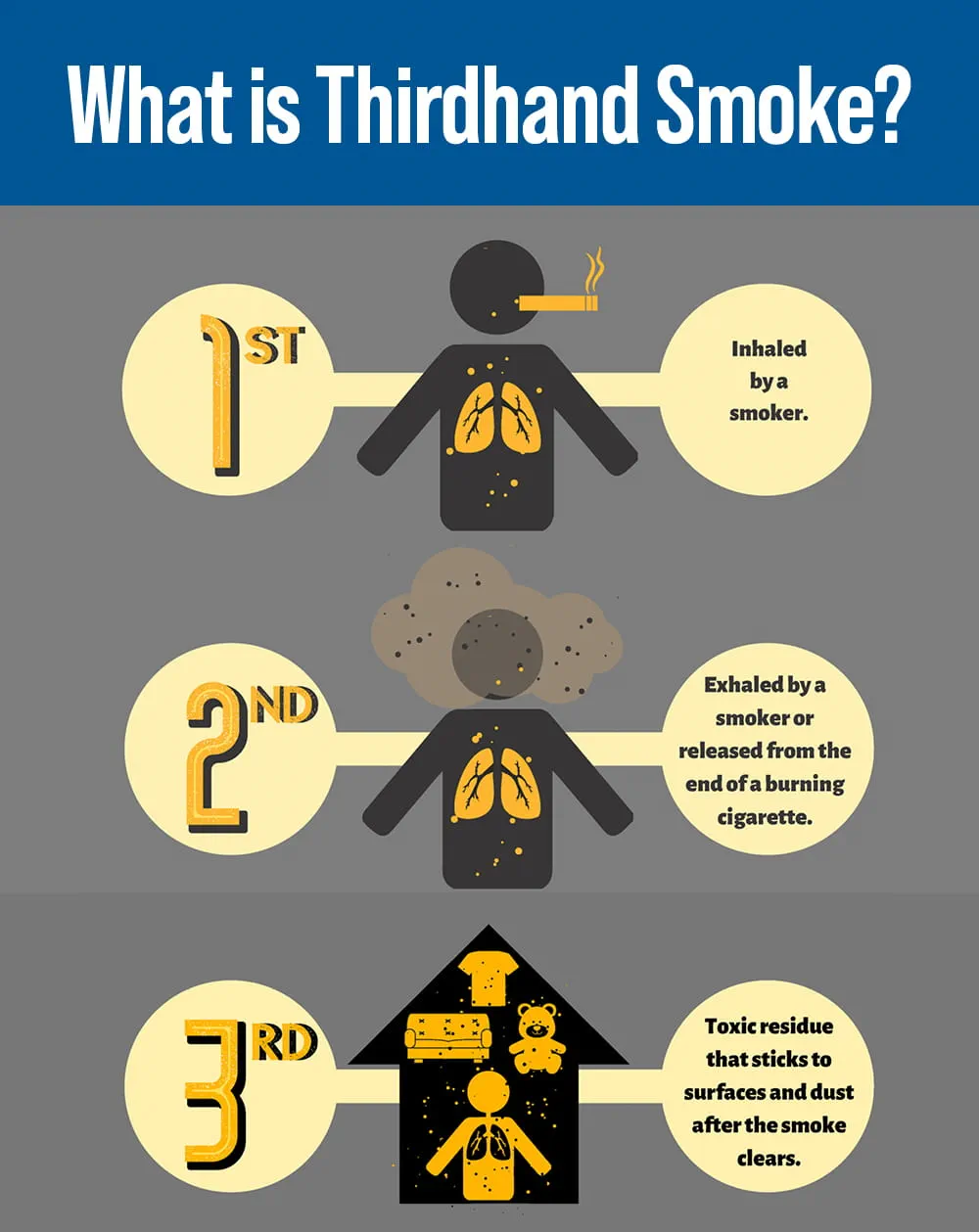Key points
- Thirdhand smoke refers to the residue left by cigarettes on the surfaces, walls, and furnishings of a home even after the smoke has been cleared.
- According to a recent study, hazardous levels of thirdhand smoke can persist inside homes for long periods—even years—despite the absence of notable smoking odors.
- The cancer-causing compounds present in thirdhand smoke can be ingested by inhaling air and dust and through skin contact.
- The removal or replacement of all surfaces contaminated with thirdhand smoke can help with remediation. If this is not feasible, it is advisable to “regularly open windows to create a cross-breeze, frequently wash fabrics and wipe surfaces, and regularly vacuum with a HEPA filter”.
What is thirdhand smoke?

Smoking is a major public health problem around the world. While most people are familiar with the concept of secondhand smoke, thirdhand smoke is less commonly discussed.
Thirdhand smoke is defined as the chemical residue deposited by a cigarette on the surfaces, walls, and furnishings of a home after the smoke clears.1 A chemical reaction between the nicotine in cigarette smoke and the nitrous acid present in air leads to the production of a group of three compounds known as tobacco-specific nitrosamines (TSNAs).2 This trio of TSNAs creates thirdhand smoke, which can remain in a home for months or even years.1,2 Notably, because thirdhand smoke is generated from nicotine, it can also be produced by e-cigarettes and vapes, which are sometimes considered to be “cleaner” alternatives to cigarettes.1,2
In a recent study, researchers from the U.S. Department of Energy’s Lawrence Berkeley National Laboratory (Berkeley Lab) reported that the levels of TSNAs in homes where smoking has regularly occurred are often beyond safety limits.1,2
Harms of thirdhand smoke
While brief visits to places where smoking has regularly taken place are unlikely to cause harm, long-term exposure is dangerous for individuals living in such homes.1 Notably, two of the three TSNAs present in thirdhand smoke, including (4-(methylnitrosamino)-1-(3-pyridyl)-1-butanone) or NNK and N’-nitrosonornicotine or NNN, are known to be carcinogens.1 In addition, there are several other risks associated with thirdhand smoke too.1

Methods of detecting thirdhand smoke
It is challenging to detect the presence of thirdhand smoke inside a home.1 One reliable sign of thirdhand smoke pollution is the smell of stale tobacco smoke.1 When such an odor is present, a home is likely contaminated by thirdhand smoke.1
However, it is important to note that thirdhand smoke may still be present, even in the absence of tobacco odors.1 This is because not all chemicals present in thirdhand smoke are odorant.1
To solve this problem, researchers from the Thirdhand Smoke Consortium are testing the feasibility of a DIY home-testing kit for thirdhand smoke.1 This tool could potentially improve the detection of thirdhand smoke and contribute to the mitigation of its health hazards.1
Controlling the levels of thirdhand smoke
Needless to say, it is important to control the levels of thirdhand smoke and preferably even eliminate it. Unfortunately, this is not easy.
Deep cleaning is one way to get some relief.1 Researchers recommend the following1:
- Regularly opening windows to create a cross-breeze
- Regularly washing fabrics and cleaning surfaces
- Regularly vacuuming with a HEPA filter
Other possible methods include painting and cleaning using ozone generators, although the effectiveness of these approaches is not clear currently.1
Importantly, however, it must be noted that these solutions are simply stop-gap measures.1 They do not get rid of thirdhand smoke reservoirs, which can re-emit toxins into the home environment.1
Thus, the most effective strategy is to remove and replace reservoirs, such as furniture and decorations—including couches, drapes, carpets, drywall, and other materials that thirdhand smoke can easily cling to.1
Ultimately, the success of these countermeasures will depend on the level of the original contamination.
Conclusion
Thirdhand smoke in homes is an underrecognized health hazard. It can persist in homes for years without exhibiting any obvious signs and can increase the risk of cancer. Hence, indoor smoking should be avoided. Home spaces that have witnessed regular smoking should be cleaned frequently and surfaces that thirdhand smoke can cling to should ideally be replaced.
Reference
- ‘Thirdhand smoke’ may last longer than you think and damage your health. Medicalnewstoday.com. 2022. Available from: https://www.medicalnewstoday.com/articles/thirdhand-smoke-cigarettes-may-last-longer-than-you-think-damage-health
- Tang X, Benowitz N, Gundel L, Hang B, Havel CM, Hoh E, et al. Thirdhand Exposures to Tobacco-Specific Nitrosamines through Inhalation, Dust Ingestion, Dermal Uptake, and Epidermal Chemistry. Environmental Science & Technology. 2022;56(17)12506–12516.

